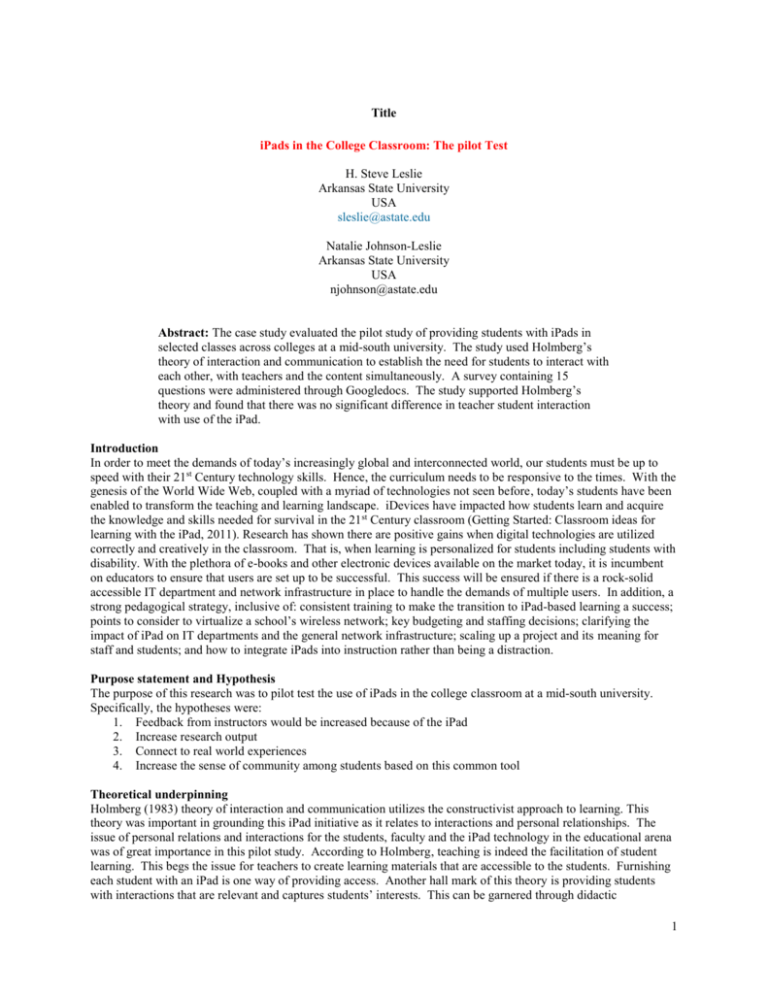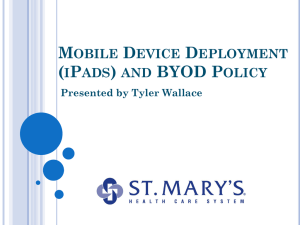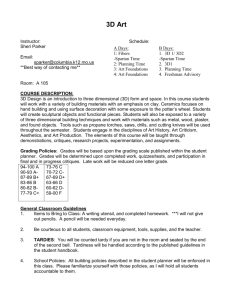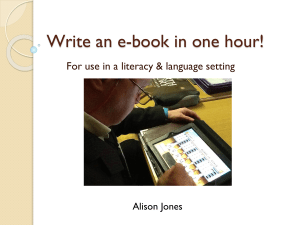Holmberg Theory Dialogue by `Holmbergers` (2013
advertisement

Title iPads in the College Classroom: The pilot Test H. Steve Leslie Arkansas State University USA sleslie@astate.edu Natalie Johnson-Leslie Arkansas State University USA njohnson@astate.edu Abstract: The case study evaluated the pilot study of providing students with iPads in selected classes across colleges at a mid-south university. The study used Holmberg’s theory of interaction and communication to establish the need for students to interact with each other, with teachers and the content simultaneously. A survey containing 15 questions were administered through Googledocs. The study supported Holmberg’s theory and found that there was no significant difference in teacher student interaction with use of the iPad. Introduction In order to meet the demands of today’s increasingly global and interconnected world, our students must be up to speed with their 21st Century technology skills. Hence, the curriculum needs to be responsive to the times. With the genesis of the World Wide Web, coupled with a myriad of technologies not seen before, today’s students have been enabled to transform the teaching and learning landscape. iDevices have impacted how students learn and acquire the knowledge and skills needed for survival in the 21st Century classroom (Getting Started: Classroom ideas for learning with the iPad, 2011). Research has shown there are positive gains when digital technologies are utilized correctly and creatively in the classroom. That is, when learning is personalized for students including students with disability. With the plethora of e-books and other electronic devices available on the market today, it is incumbent on educators to ensure that users are set up to be successful. This success will be ensured if there is a rock-solid accessible IT department and network infrastructure in place to handle the demands of multiple users. In addition, a strong pedagogical strategy, inclusive of: consistent training to make the transition to iPad-based learning a success; points to consider to virtualize a school’s wireless network; key budgeting and staffing decisions; clarifying the impact of iPad on IT departments and the general network infrastructure; scaling up a project and its meaning for staff and students; and how to integrate iPads into instruction rather than being a distraction. Purpose statement and Hypothesis The purpose of this research was to pilot test the use of iPads in the college classroom at a mid-south university. Specifically, the hypotheses were: 1. Feedback from instructors would be increased because of the iPad 2. Increase research output 3. Connect to real world experiences 4. Increase the sense of community among students based on this common tool Theoretical underpinning Holmberg (1983) theory of interaction and communication utilizes the constructivist approach to learning. This theory was important in grounding this iPad initiative as it relates to interactions and personal relationships. The issue of personal relations and interactions for the students, faculty and the iPad technology in the educational arena was of great importance in this pilot study. According to Holmberg, teaching is indeed the facilitation of student learning. This begs the issue for teachers to create learning materials that are accessible to the students. Furnishing each student with an iPad is one way of providing access. Another hall mark of this theory is providing students with interactions that are relevant and captures students’ interests. This can be garnered through didactic 1 conversations and interactions that are both formal and informal. Having students using a variety of media—video, audio, text and graphics coupled with proper page layout of the material can help to motivate the learners and can facilitate greater learning outcomes. Holmberg recommends the following: having flexible schedules; student work at their own pace; students are given time to digest new information; there is specific guidance that does not stifle creativity; intellectual honesty is emphasized; students being required to use primary sources; encouraging the use of critical and divergent thinking that facilitates problem solving; having a friendly and personal tone; opportunities for constant collaboration; and help students engage students emotionally with the content by appealing to all of the students sensory modalities (Holmberg Theory Dialogue by ‘Holmbergers’ 2013). All these interactions do form a web of constant activities that are multi-dimensional and not unilateral. Hence, students are expected to interact with their teachers, with each other and with the content as shown in figure1 Student Interaction Teacher Content Figure 1 shows the interaction of students with teachers and the content. According to Moore (1989) the student content interactions will occur when students become engaged with text in the various media—be it print or electronic. Student to student interaction will be facilitated by the student using various methods to communicate and collaborate with others about the content. There for students can use features such as blogging, e-mail, face-toface conversations’, texting etc., to interact with each other. Finally, the student teacher communication is facilitated by any means available electronically or face-to-face. The bottom line is that students are getting engaged at multiple levels with stakeholders in the teaching and learning environment. Method The research design was a case study, the case/unit of analysis being the classes that participated in the iPad initiative (Stake, 1995; Yin, 1994). The methods used for collecting data included an original student survey developed by the authors using the literature on technology integration as a framework. The survey included 15 items. Fourteen of the questions were quantitative requiring a Yes-No or Likert-type questions. The final question #15 was an open-response question requiring a qualitative response. Survey data were analyzed using Googledocs. The statistics used were means and frequencies. Context During the 2011-2-12 school year, this mid-south university decided to pilot the use of iPads in the classroom. After multiple meetings with the various stakeholders, it was decided that faculty should be the ones who steer the integration of iPads in their classes. Therefore, a committee of faculty representing all colleges was pulled together to form an advisory board. Faculty members on this team were asked to submit proposals for obtaining iPads in 2 their classrooms. These proposals were peer reviewed and ranked by faculty to decide which proposals would be funded. Based on the ranking, from the rubric used and the money available to purchase the number of iPad’s requested, 12 of 22 projects were earmarked to be funded spring and fall 2012. Eventually, the projects funded demonstrated effective pedagogical use of the iPads as a tool to aid rather than to replace quality instruction in the classroom. So, it was not about having the technology but rather a coupling of the iPad technology with knowledge of integration and application on the part of the educators (Reiss, 2013). Findings and conclusions Starting in fall 2012 there were 150 students who had iPads to help them in their classes. These students were from across campus in the following colleges: education, business, honors college, science, humanities and social sciences. At the start of the semester, each instructor who was a part of the iPad initiative rolled out there iPads in their first class session. Students had to sign a waiver regarding the physical condition of the iPad received. All students had to sign a liability agreement for any damage to the iPads. At the start of fall 2012 semester the students were asked to complete an on-line survey regarding their learning experiences. Items for the survey were obtained from…. All students participating in the iPad initiative were sent an e-mail with the link to complete the survey in Googledocs. From the total of 150 students, 115 completed the survey for a response rate of 76.7%. Based on the hypothesis postulated the findings are as follows: Hypothesis 1: Feedback would be increased because of the iPad As shown on Figure 2, students were asked about receiving immediate feedback from instructor. 1. How effective was the iPads in getting immediate feedback from your instructor? Yes, highly 50 43% Yes, somewhat 34 30% No 31 27% Seventy-three percent of the respondents indicated high or somewhat. In keeping with Holmberg’s theory, feedback is important as a means to facilitate student teacher relationship. Hypothesis 2: Increase research output no question addressed this… Participants were asked, were iPads used to improve any of the following experiences in your classroom (you may if this choose more than one). Seventy-four percent of the participants indicated an increase in research. Simultaneously, 89% indicated an impact on learning where as 66% indicated increased output on teaching. Hypothesis 3: Connect to real world experiences Participants were asked explicitly how the iPads helped with real world connections. Eighty-three percent indicated there were some connections made to the real-world 2. How effective was the iPad you used in relating your course content to real world experience? 3 Yes, highly 57 50% Yes, somewhat 47 41% No 11 10% In conjunction to hypothesis 3, students were asked about preparing them for work in the global village. The responses showed that 79% of the students indicted this were very useful or usefulness. Only 23% was not quite sure. Hypothesis 4: Increase the sense of community among students based on the common tool Students’ responses were split when answering the question of community building. Forty-seven percent indicated agree or strongly agree whereas a significant 30% were not sure. Reasons for such were not explored in this pilot study. My iPad help to build a sense of community with my fellow classmates. Strongly Agree 27 23% Agree 28 24% Not Sure 35 30% Disagree 15 13% Strongly Disagree 9 8% As shown above, 47% indicated their agreement with the iPads helping them to build a sense of community with other classmates. Community building or student-to-student interaction is an important o Holberg’s theory used to underpin this study. Lessons learned from students anecdotal responses 1. The iPads are great for researching topics. They allow quick and easy access vs. having to go and find a computer somewhere on campus. Cuts back on the time spent when performing research for projects. 2. I am glad I got to use one while in college. It helped the class go smoother and helped me see what was on the board considering I have bad eye sight. 3. The iPad devices can be used to enhance the learning experience. Yes, they can replace expensive and constantly outdated published textbooks. Yes, they give "real-time" information providing more instruction Implications and recommendations 1. Need for strong IT network solutions and Wi-Fi access 2. Training of the faulty to use the iPads themselves 3. Students liked the portability 4. They would recommends that having a iPad is a requirement in classes 5. Windows based devices were recommended for future use. 6. IPads and tablets are becoming more and more common on campuses and in the work place. Their functionality, along with the endless number of applications available is motivating a trend towards a more interactive society 7. With a more organized approach, these devices can not only enhance our learning experience but can easily make learning the "latest and greatest" information more accessible and, in my opinion, more exciting. No device can take the place of a qualified educator but they can be used to help content stick in the minds of student by allowing us to tailor our instruction time in a more interesting way 4 References Holmberg Theory Dialogue by ‘Holmbergers’ (2013). Available on-line at http://www.xtranormal.com/watch/12272145/holmberg-theory-dialogue Getting Started: Classroom ideas for learning with the iPad (2011). Department of Education and Earl Childhood Development. Melbourne Holmberg, B. (1983). Guided didactic conversation in distance education. In D. Sewart, D. Keegan, & B. Holmberg (Eds.), Distance Education: International Perspectives (p. 114-122). New York: St. Martin's Press. Kelsey, K. & D'souza, A. (2004). Student Motivation for Learning at a Distance: Does Interaction Matter? Online Journal of Distance Learning Administration, Volume VII, Number II.State University of West Georgia, Distance Education Center. West Georgia Moore, M. G. (1989). Three types of interaction. The American Journal of Distance Education, 3(2), 1-6. Pittard, Vanessa (2009) Becta Research: Young People, Schools and Technology-Supported Learning. Powerpoint presentation. In: ALT-C 2009 "In dreams begins responsibility" - choice, evidence and change, 8 - 10 September 2009, Manchester Reiss, D. (2013). Text books to tablets Prparing for digital education by 2017. DA DistrictAdministration solutions for school district management. Available at http://www.districtadministration.com/article/textbooks-tablets Stake, R. E. (1995). The art of case study research. London: Sage Publications. Yin, R. K. (1994). Case study research: Design and methods. (2nd ed.). Newbury Park, CA: Sage . Publications. 5







